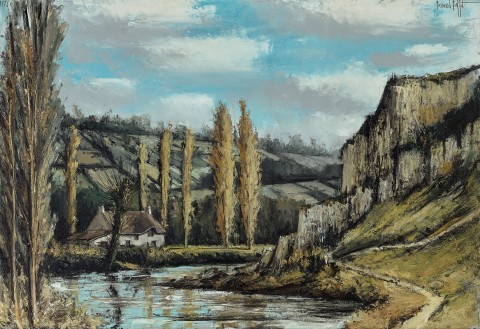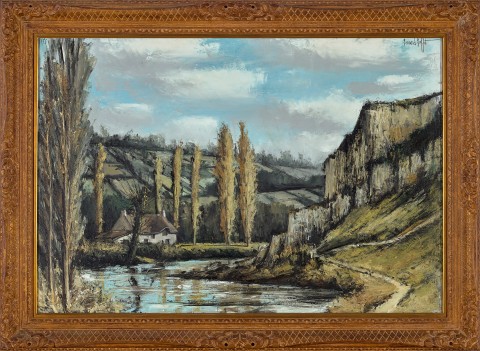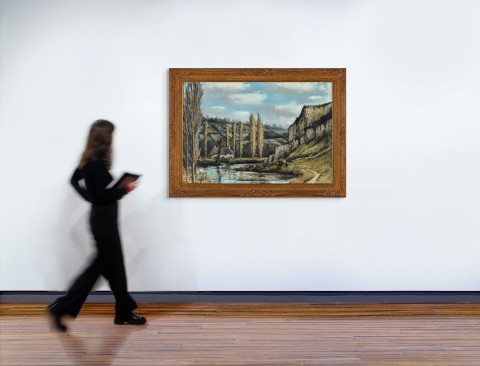ENVIRONS DE SAINT-GILLES, 1975
BERNARD BUFFET
oil on canvas
89.5 x 130.0 cm
signed upper right: Bernard Buffet
dated upper left: 1975
inscribed verso: environs de / Saint – Gilles / (Yonne) / AH 75 / La cure / et les Roches
Galerie Maurice Garnier, Paris (bears gallery stamp verso)
Galerie Taménaga, Japan (label attached verso)
Private collection, Japan
Thence by descent
Private collection, Queensland
We are grateful to Galerie Maurice Garnier, Paris, for their assistance with this catalogue entry.
By 1975, Bernard Buffet, once hailed as France’s finest post-war painter,1 had weathered the worst of institutional and critical denigration in his home country, finally being elected into the Académie des Beaux-Arts in March 1974, the youngest member to hold a seat within the venerable institution. Now, some thirty years after his death, Buffet’s abundant oeuvre and its influence on the course of modern art are being comprehensively reevaluated. Growing up in occupied France and coming of age during the material privations and societal malaise that followed World War Two, Buffet’s acclaimed early works were infused with Gallic spleen2, sapped of colour and spatial depth. In stark contrast to these spiky, grey, and anguished paintings, Buffet’s picturesque landscapes of the 1970s display a yearning for bucolic tranquillity and a re-affirmation of his links with the great artists of the French pantheon whom he idolised, namely the 19th-century painter, Gustave Courbet.
Mirroring the semi-rural setting of his magnificent medieval residence, the Château Villers Le Mahieu – the Buffets’ family residence from 1971 to 1979 – the artist’s artworks throughout the seventies had familiar and comfortable subject matter: his young children, boats and harbours, and local landscapes of the French countryside. Environs de Saint-Gilles, 1975 depicts a dramatic landscape dominated by a steep valley through which runs a fast-flowing stream. Counterbalancing a row of towering quivering poplar trees growing on the riverbanks is a rugged limestone cliff face surging from the landscape on the right-hand side of the composition. Although Buffet was approximative with the exact locations of his landscapes in his titles, often using words such as ‘near to’ and ‘surrounds of’, this defining geological feature was singled out within his title as ‘Les Rochers’. In contrast to previous picture-postcard views of notable landmarks, Environs de Saint-Gilles, and many other paintings from this period were conceived (and marketed in solo exhibitions at Garnier Gallery) as typical and unremarkable landscapes, familiar to many local audiences and quaintly French to his many admirers overseas.
A member of the L’Homme Témoin (Man as Witness) group supporting expressive social realism as opposed to modern abstraction, Buffet emphasised the everyday nature of his subject matter, insisting ‘realist painting for me is concreteness… the representation of things.’3 In this vein, Buffet’s early landscapes were mostly restricted to flat deserted cityscapes, whose rectilinear structure and sepulchral greyness suited the artist’s recognisable graphic style. Here, Environs de Saint-Gilles, although also devoid of human presence and painted with a reduced tonal palette, radiates with soft organic untidiness and vital forces. Buffet looked to Courbet, a painter he most admired, for the comforting indeterminacy of his landscape; the conception of the landscape as a reflection of one’s mood (this painting was created during a rare period of sobriety in Buffet’s life), as well as for guidance on the technical savoir-faire of creating a realist landscape. Echoing Courbet’s paintings of rocky outcrops and streams of Ornans, Environs de Saint-Gilles used foundational black ground over which texture is palpably built up with the use of a palette knife and expressive scumbling. Courbet was a titanic figure in the post-war discourse on painting, a guiding figure for opposing stylistic factions of social realists and formal abstractionists.4 For Buffet, Courbet was ‘the painter’ upon whom he modelled himself, and in whom he found comfort during difficult and lonely periods of his long life.
1. Connaissance des Arts, Paris, No. 36, 15th February 1955
2. Coined by writer Charles Baudelaire, ‘spleen’ describes a French feeling of melancholy and existential ennui.
3. Charbonnier, G., Le Monologue du peintre, Julliard, Paris, 1959, reprinted 2002, pp. 213 – 214
4. Roob, A., ‘Bernard Buffet - Terrain Vague - Dangerous Terrain’, Melton Prior Institute, 2008, see https://meltonpriorinstitut.org/content/en/bernard-buffet-terrain-vague-... (accessed 27 May 2024)
LUCIE REEVES-SMITH


